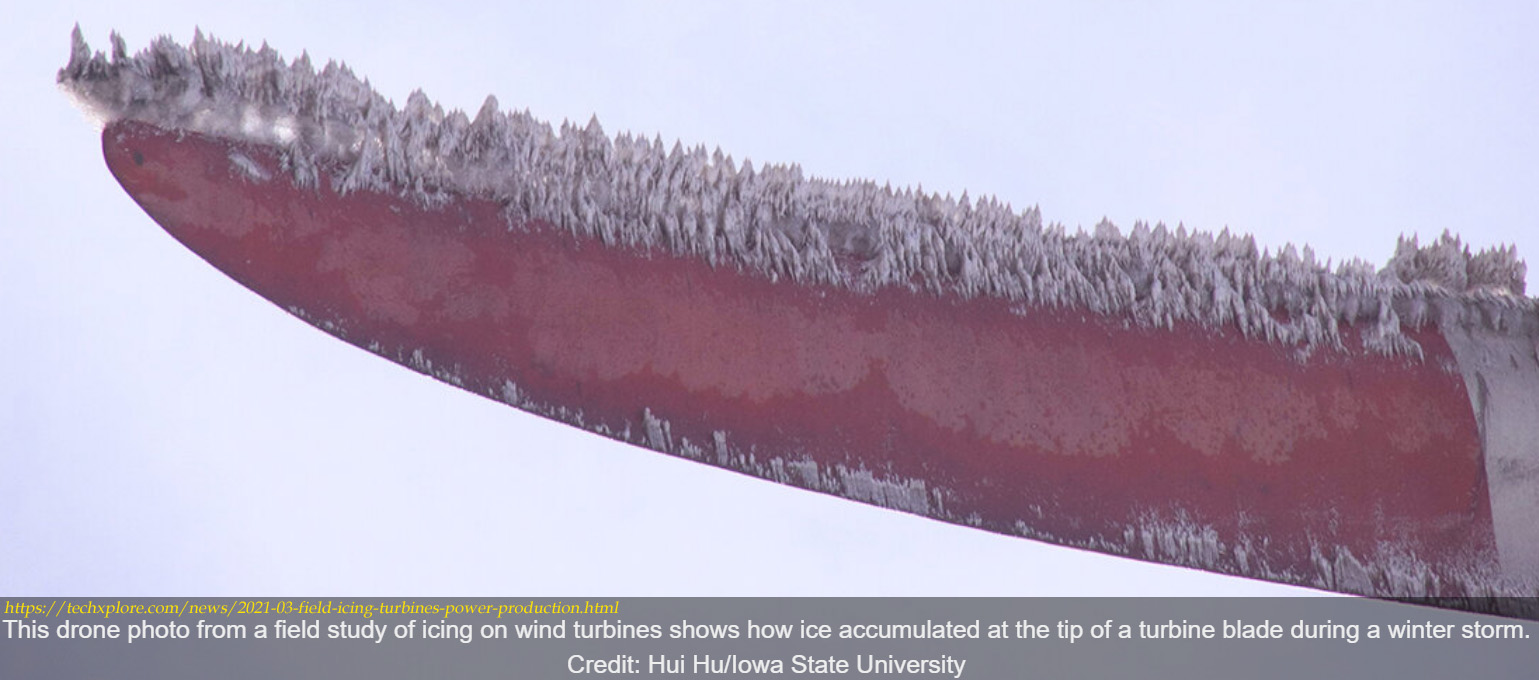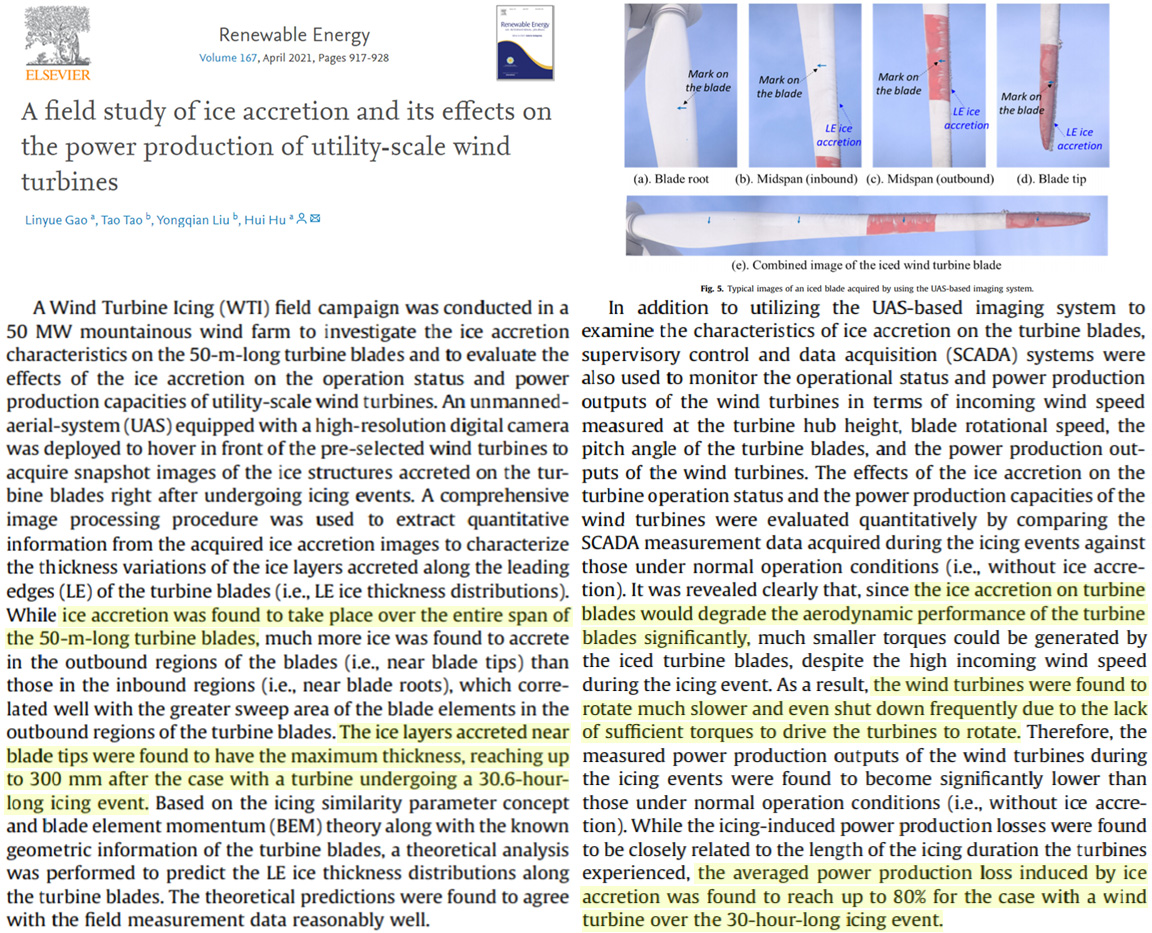A new study affirms 0.3 m (12 inches) of ice buildup along the tip of a wind turbine’s 50-meters-long blades during a typical ice storm dramatically reduces the blades’ capacity to rotate – even in very windy conditions. The averaged power production loss induced by this ice accretion reaches up to 80%.

Image Source: TechXplore.com
The evidence that wind energy cannot reliably meet even the most fundamental need to keep us warm during harsh winter weather continues to accumulate. Nearly 4.5 million Texas residents experienced these grid failure consequences last month.
When a wind turbine blade spins in cold, wet weather, the ice buildup can span the length of the 50-meters-long blade, severely disturbing the aerodynamic balance of the entire 150-meters-tall machine.
Drone images from a new study (Gao et al., 2021) reveal the tips of blades can accumulate 300 mm of ice during an ice storm. Consequently, the blades may slow dramatically or even shut down altogether. The averaged power loss in an icing-induced slowing of blade rotation is 80% when compared to non-iced turbine blades.
In other words, when the weather is cold, wind turbines cannot be relied upon to supply us with the energy we need.






I would have thought the unbalance of the rotating mass due to different levels of ice would play hell with the bearings, & be the biggest problem..
Similar problems can occur in aviation if propellers ice up; the vibrations can cause structural damage and even pull the engine from its firewall mount.
Did the people foisting these silly contraptions on us not see this coming? It’s freakin’ obvious to anyone with any aviation (or similar) experience.
(Sorry, bumped publish before I was done.)
One method that *might* be applicable here is one that Cirrus has put into their SR-22s. It was originally just an SYA if you got in icing conditions (enough to get you out, hopefully), but it worked so well that they upgraded it for the G5 (and later) models and got FAA approval for flight in known icing conditions.
Basically, the propylene glycol stuff I mentioned below is (by activating the system) dripped onto the leading edges and the prop – this is called the “weeping wing” method, and while you don’t want to fly that into a blizzard or severe icing situation, it works quite well for flying through sub-freezing-temperature clouds – the system, if the fluid tank is full, can give you something like three hours of protection.
How that would be deployed and how well it would work on a whirlygig I know not. But given how BIG they are, it might be tough to keep the stuff on – and to keep it on basically for a lot more than the three hours that the SR22 system gives you. And since they are much bigger… it would take a lot of continual deployment of a fluid that is $15/gallon or more…
A quick and cheap fix would be to spray-paint the blades with a hydrophobic coating… water can’t stick to it, so ice can’t build up.
Or a coating that’s so slick that nothing sticks to it. Even if ice did start to build up, the slick coating would ensure it would slide off without building up much.
(I think there’s a response further down that’s supposed to be a response to this one – but I’ll just move ahead with my response here.)
It’s something that would be a nice idea, but it doesn’t exist. This is all basically the same problem of icing of aircraft wings (or more generally, aircraft airfoils – that includes helicopter blades, which are rotating airfoils).
For an aircraft on the ground, the only method we have is a combination of de-icing fluid and anti-icing fluid – won’t go into details of the differences, but this is stuff that is (one of them) orange and (the other) green that is sprayed on aircraft that have to taxi and depart in ice/snow conditions.
Both variants are concoctions based on propylene glycol; exact details are proprietary trade secrets, but they are based on “non-toxic anti-freeze.” They cost about $15/gallon; when your flight is being “de-iced” after pushback but before taxi, it costs several thousand dollars to do the job. Any ice present has to be removed (de-iced), particularly from the airfoil (even frost can disrupt the airflow enough to reduce lift by 30%), while a preventative (anti-ice) is put on to prevent the formation of ice during taxi, take-off, and climb-out – until the aircraft’s on board anti-icing/deicing technology can be brought to bear.
Airborne, the usual method these days is to channel engine heat onto the leading edges to remove ice or prevent ice buildup; deicing boots were once common (prop planes – not enough engine heat) but are uncommon now as inferior; electric heating is (I think) also rare, particularly in jets.
Try applying any of those methods to the whirlygigs. Not a good situation for them.
300 mm is 30 centimeters. 25.4 centimeters is equal to 10 inches, add another 4.6 centimeters to equal 30 cm.
Another inch and 3/4, almost a foot tall of ice. If it is 4 inches wide and 50 meters in length, 150 feet, close enough, the volume of the ice accumulation can be determined, roughly.
LxHxW=V
150x1x1/3=50 cubic feet of ice.
One gallon of water weighs 7.84 lbs, 7.84×50=392 pounds of ice on one blade, times three blades, 1176 lbs of ice accumulation on the blades.
The numbers work, anyhow.
Liars figure and figures lie. lol
Just a guesstimate, the crystals formed will make less in an accurate estimation.
Provides an idea of how much there might be if estimates of accumulations have any accuracy, veracity.
Just stop manufacturing wind turbines and your problems are solved, they just aren’t there.
The wind industry is parasitic, can’t stand on its own, needs hydrocarbons from the get go.
The figures are not correct.
There are 7.48 gallons of liquid water in a cubic foot, therefore, the number is even higher.
7.84×7.48=58.6432 lbs of H2O per cubic foot, times 50 cubic feet, you will have 2932.16 lbs on each blade or approximately 8900 pounds of ice on three blades of a wind turbine.
The figures did lie, but now are true and correct.
My mistake. har
That would be great if it would work. Helicopter blades have the same problem and any coating is quickly eroded away. Electric heat works but is heavy, complicated to maintain, can cause problems to the structural integrity over time, reduces life span, has a limit due to icing intensity and adds to the cost.